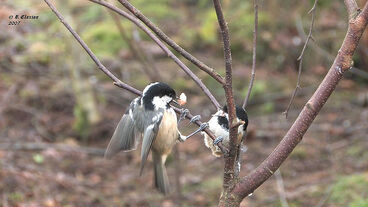
Coal Tits - C.N.Images
The Coal Tit (Periparus ater), is a passerine bird in the tit family Paridae. It is a widespread and common resident breeder throughout temperate to subtropical Eurasia and northern Africa.
Description and systematics[]
The Coal Tit is 10–11.5 cm in length, and has a distinctive large white nape spot on its black head. The head, throat and neck of the adult are glossy blue-black, setting off the off-white sides of the face (tinged grey to yellow depending on subspecies) and the brilliant white nape; the white tips of the wing coverts appear as two wingbars. The underparts are whitish shading through buff to rufous on the flanks. The bill is black, the legs lead-coloured, and irides dark brown.
The young birds are duller than the adults, lacking gloss on the black head, and with the white of nape and cheeks tinged with yellow.
While searching for food, Coal Tit flocks keep contact with incessant short dee or see-see calls. The species' song – if "song" it can be called – is a strident if-he, if-he, if-he, heard most frequently from January to June, but also in autumn.
Ecology[]
It is typically a bird of temperate humid conifer forest, but apart from that shows little habitat specificity. In Bhutan for example Coal Tits are fairly common residents above the subtropical zone, at about 3,000-3,800 m ASL, and are found in forests dominated by Bhutan Fir (Abies densa) as well as in those characterized by Himalayan Hemlock (Tsuga dumosa) and rhododendrons.
The Coal Tit is an all-year resident throughout almost all range, making only local movements in response to particularly severe weather; only the Siberian birds have a more regular migration. Very rarely, vagrants may cross longer distances; for example the nominate subspecies of continental Europe was recorded in Ireland once in 1960 and once before that, but apparently not since then.

Coal Tit at Feeder - Bacaloca
Coal Tits will form small flocks in winter with other tits. This species resembles other tits in acrobatic skill and restless activity, though it more frequently pitches on a trunk, and in little hops resembles a treecreeper (Certhia). Its food is similar to that of the others; it is keen on beechmast, picks out the seeds from fir (Abies) and larch (Larix) cones, and joins Carduelis redpolls and siskins in alders (Alnus) and birches (Betula). It will also visit gardens to feed on a variety of foods put out, particularly sunflower seeds.
A favourite nesting site is a hole in a rotting tree-stump, often low down, and the nest is deep within the hole; holes in the ground, burrows of mice or rabbits, chinks between the stones in walls, old nests of Pica magpies or other large birds, and squirrel dreys are also occupied. The materials, moss, hair and grass, are closely felted together, and rabbit fur or feathers added for lining. Seven to eleven red-spotted white eggs of the usual tit type are laid, usually in May; this species breeds usually once per year.
Being common and widespread, the Coal Tit is not considered a threatened species by the IUCN.


